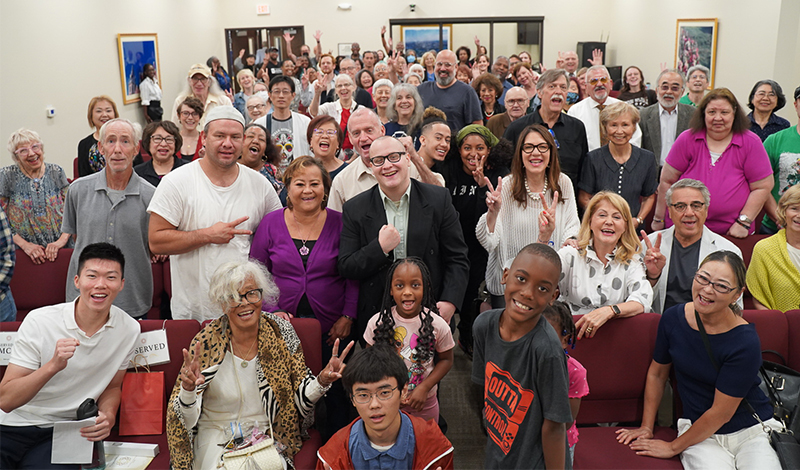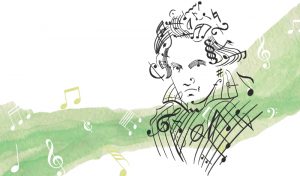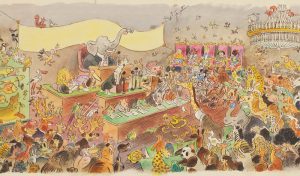The following excerpts are from Ikeda Sensei’s first of four lectures on Nichiren Daishonin’s treatise “The Selection of the Time.” See the January–February 2011 Living Buddhism for the full lecture, starting on p. 72.
Introduction
My mentor, second Soka Gakkai President Josei Toda, stood up alone amid the confusion of postwar Japan to rebuild the Soka Gakkai. He spoke out passionately for the cause of kosen-rufu, and his words continue to resound in my heart to this very day. He cried out:
I don’t want to see the people plunged into even greater misery than they have already experienced during the war.
• • •
The people of the Latter Day are steeped in suffering. … Who is going to save and help this troubled world?
• • •
Now is the time for kosen-rufu!
Whenever Mr. Toda came across a report of conflict in some part of the world or of a disaster in Japan or elsewhere, he grieved over the painful plight of those affected. And he would renew his resolve to propagate the Mystic Law so that such suffering might never recur. He genuinely wished with all his heart to eradicate misery from the face of this earth, and he remained committed to this goal until the end of his life. To me, this has always epitomized the spirit of a genuine Soka Gakkai leader.
“How can I help those suffering and living in abject misery right in front of me?” “If I don’t take action now, when will I?” Sensing the time had come, Mr. Toda courageously took personal leadership for kosen-rufu. He declared, “The fundamental reason for the Daishonin’s appearance in this world was to help people throughout Japan—no, throughout Asia and indeed around the globe—become happy through the teaching of Nam-myoho-renge-kyo.”
Buddhism always takes into account the time, because it is concerned with the welfare of those living at the present moment. Starting with this installment, we will turn our attention to Nichiren Daishonin’s well-known treatise on this subject, “The Selection of the Time.” The title theme has great significance for Nichiren Buddhism, because “selecting the time” means correctly selecting the Latter Day as the time for the widespread propagation of the Mystic Law—the time for kosen-rufu.
Born in the Latter Day of the Law, the Daishonin was alive at just the right time. Deeply recognizing the significance attaching to this time period in terms of Buddhism, he unerringly selected the most appropriate teaching for the Latter Day, and propagated it in order to free people of the present age from suffering.
The right time for propagation, the right person to initiate the propagation and the right teaching for propagation—when these three vital elements of time, person and the Law are in place, the way will open for relieving people from suffering on a fundamental level.
During his day—a period coinciding with the start of the Latter Day, an age that the sutras describe as rife with conflict, quarrels and disputes—Nichiren chose as the teaching most suited to this time the great Law of Nam-myoho-renge-kyo, which is implicit in “The Life Span of the Thus Come One,” or “Life Span,” the 16th chapter of the Lotus Sutra, and represents the essence of this sutra.
Nam-myoho-renge-kyo is the seed of Buddhahood; it is the cause by which all Buddhas attain enlightenment. When we dispel the clouds of darkness or ignorance enveloping our lives by means of the “sharp sword” of faith in the Mystic Law, our lives will be illuminated by the light of the Mystic Law and instantly come to manifest the dignified attributes that we inherently possess (see “The Real Aspect of the Gohonzon,” The Writings of Nichiren Daishonin, vol. 1, p.832). In other words, we can tap the Mystic Law’s infinite power within our lives and reveal our innate Buddhahood. Simultaneously obtaining the true cause and true effect of Buddhahood in our lives through the power of faith is the working of Nam-myoho-renge-kyo.
When we awaken to the equal and impartial Law of Nam-myoho-renge-kyo, we come to feel a deep connection to others, and as more people share this kind of kinship, it will bring humanity closer together. We also gain the strength to triumph over the tumultuous times of the Latter Day and create peace and happiness. The key is for all of us to manifest in our lives the power of Nam-myoho-renge-kyo, the fundamental Law of enlightenment. This is the purpose of our efforts for kosen-rufu. Further, through our ongoing efforts to spread the correct teaching, we can overcome the crisis of the decline of the Law—a situation in which “quarrels and disputes prevail, and the pure Law is obscured and lost” (“On Practicing the Buddha’s Teachings,” WND-1, 391).
Nichiren Daishonin is the Buddha of the Latter Day of the Law who initiated this struggle at the start of this evil age. “The Selection of the Time” details his valiant efforts as the votary of the Lotus Sutra to propagate the Mystic Law. This writing can therefore be viewed as proclaiming the identity of the teacher who correctly selects the time—the correct teacher of Buddhism who leads all people to enlightenment in the Latter Day of the Law.
Moreover, the Latter Day continues into the eternal future. Especially, in this writing, Nichiren states that “great struggles and disputes such as have never been known in the past” (“The Selection of the Time,”WND-1, 542) will unfold throughout the world. “Great struggles and disputes” matching this prediction certainly arose during the 20th century, which has been dubbed the “century of war.” Amid this turmoil, the Soka Gakkai emerged.
Founding Soka Gakkai president Tsunesaburo Makiguchi died in prison for his beliefs, refusing to compromise when persecuted by the Japanese military regime that instigated one of the most horrific wars of the 20th century. This is the source of the Soka Gakkai’s vital inheritance of Nichiren Buddhism as a teaching for realizing peace.
What is the best way to spread Nichiren Buddhism in the world today, and how can we truly make it shine as a philosophy contributing to the peace and welfare of all humanity? Herein lies the mission and challenge of the Soka Gakkai, which appeared at this most timely juncture in the present age.
I myself have devoted constant thought to how we should propagate this humanistic teaching for people’s happiness and for world peace, and have translated my ideas into action. Above all, for these past 50 years, I have taken full responsibility for kosen-rufu and striven earnestly to convey Nichiren’s spirit to the world. In doing so, I have always paid close attention to the time and also chosen the most appropriate time to take action, just as taught in this writing.
As a disciple of Josei Toda and a human being, I have worked tirelessly for a world without war and have overcome countless obstacles to bring people and nations closer together and to build bridges of peace through trust and friendship. I have sought to demonstrate by example to the youth who will carry on in my footsteps that, by understanding the time and taking action that accords with that time and also by pooling the power of ordinary people everywhere, we can definitely accomplish a lasting legacy of creating peace.
It is now time for the Soka Gakkai to further consolidate the already sound foundation it has established for kosen-rufu in Japan and around the world. This year, 2010—a year of many important anniversaries for the Soka Gakkai—marks a brilliant milestone in the annals of kosen-rufu. At this auspicious time in our history, I hope you’ll join me in studying “The Selection of the Time” in order to reaffirm just how significant it is that the time of worldwide kosen-rufu predicted by the Daishonin has arrived in the present age. Let’s also continue to do our utmost to create the right time for furthering kosen-rufu.
I now begin my lecture, hoping it may be a source of courage and inspiration as you pursue your goals with a lofty sense of pride and mission as people gathered at this momentous time to dedicate your lives to the cause of kosen-rufu.
• • •
“Selecting the Time”—Choosing the Right Time
When it comes to studying the teachings of Buddhism, one must first learn to understand the time. (“The Selection of the Time,” The Writings of Nichiren Daishonin, vol. 1, p. 538)
In this opening passage, Nichiren Daishonin highlights the importance of the time, the main theme of this writing.
He composed “The Selection of the Time” in 1275, at age 53, while residing at Mount Minobu. It is thought to have been entrusted to a believer named Yui, who lived in Nishiyama in Suruga Province (present-day central Shizuoka Prefecture).
In October 1274, the previous year, Mongol forces had attacked Japan. This was the calamity of foreign invasion the Daishonin had predicted in his treatise of 1260, “On Establishing the Correct Teaching for the Peace of the Land.” He thus wrote “The Selection of the Time” in an environment where a second Mongol invasion seemed inevitable, and the entire country was in a state of panic and consternation.
In this writing, Nichiren clarifies how, functioning as the world’s foremost sage, he stood up alone in his defiled age rife with war and conflict to proclaim the great pure Law of Nam-myoho-renge-kyo. He explains that he has waged a selfless struggle to avert the danger of the correct Buddhist teaching perishing in the Latter Day, and to create the time for world-wide kosen-rufu in order to lead all people to enlightenment. And he concludes by calling on his disciples to continue this struggle into the future. This is the main message of “The Selection of the Time.”
At the beginning, Nichiren states that to study Buddhism “one must first learn to understand the time” (WND-1, 538). He thus makes clear that a Buddhist’s first imperative is to gain insight into the time. In context, “time” here specifically means the time for expounding the Law.
Nichiren then explains that the Buddha Great Universal Wisdom Excellence (a Buddha of the past), Shakyamuni Buddha (a Buddha of the present), Bodhisattva Maitreya (a Buddha of the future) and others never expounded the Law in their respective periods when they were waiting for the right time to come; they only did so after discerning and selecting the proper time (see WND-1, 538). …
Nichiren confirms that the main criterion for Shakyamuni commencing to preach the ultimate Law for attaining enlightenment was not whether people had developed sufficient capacity but whether the time to preach it had in fact arrived. Nichiren’s observations in this writing directly repudiated the generally accepted stance of Buddhist schools of the day that people’s capacity was more important than the time.
That doesn’t mean, of course, that he completely disregarded people’s capacity. As is clear from his letters to individual followers, he put great thought and care into conveying his message in a way that would resonate with each recipient’s capacity.
But far more important was the fact that the Latter Day of the Law is the time when it is necessary to keep proclaiming the correct teaching in order to lead all people to enlightenment, irrespective of their capacity or likely opposition. Because Nichiren was deeply aware of this, he placed the utmost importance on the time. In this writing, he discusses this factor of time at length.
• • •
Constructing a Compassionate Society of Respect for All
Nichiren Daishonin appeared in the “age of quarrels and disputes” of the Latter Day of the Law. More specifically, it was the Kamakura period (1192–1333), which saw the first ever establishment of a military regime in Japan. It was also a time when the country faced the threat of foreign invasion. Taking these circumstances into account, an apt subtitle for “The Selection of the Time” might be “Choosing Peace.”
And, as I stated at the outset, the Soka Gakkai emerged in the period between two world wars. This was a time when Japan was rushing headlong down the path to militarism. It is also a fact that the SGI was inaugurated as the Cold War continued to drag on and tensions were running high between China and the Soviet Union.
What should humanity learn from these two great wars of the 20th century? That the absolute truths that “nothing is more tragic and cruel than war” and “nothing is more precious than peace” need to become universal human values. Hence, the profound significance of our efforts to spread the life-affirming principles and ideals of Nichiren Buddhism toward the realization of lasting peace.
The “claws that are hidden in the very depths of the issue [of nuclear weapons],” of which Mr. Toda spoke in his declaration, in fact, refer to the fundamental darkness or ignorance that resides in the depths of human life. This innate darkness gives rise to deluded impulses that manifest as greed, anger and foolishness, and are the root source of all evil and misery.
The Lotus Sutra passages cited by Nichiren in “The Selection of the Time,” which I discussed earlier, accurately describe the reality of the “age of quarrels and disputes.” … The workings of fundamental darkness seek to prevent people’s innate enlightened nature from manifesting.
To battle fundamental darkness is to battle the evil or negativity inherent in human life. Genuine Lotus Sutra practitioners do not retreat a single step in this struggle. And by triumphing over the three obstacles and four devils, and also the onslaughts of the three powerful enemies, practitioners can eloquently demonstrate the brilliant potential of the fundamental nature of enlightenment or Dharma nature that all people possess. This proof upsets others’ erroneous attachments and causes them to question their beliefs.
The struggle against fundamental darkness is a challenge to break through people’s distrust and disrespect for human life and awaken them to the innate dignity of the human being. …
Our humanity must win over the devilish nature inherent in life. This is the struggle of kosen-rufu.
The purpose of Buddhism is to enfold humankind in a warm current of compassion. Mr. Toda said: “When you practice Buddhism in a way that truly matches the time, you can naturally take compassionate action.” Our efforts to treasure each person are building a compassionate society of respect for all.
Mr. Toda also said that as ordinary people we need courage to continue taking compassionate action. This, he declared, is none other than the courage to help others, the courage to improve ourselves, the courage to challenge our human revolution and the courage to work for kosen-rufu.
Now, in the 21st century, will respect for the sanctity of life and human dignity become widely established through a spiritual solidarity of conscientious people around the globe? Or will we see a prevalence of ideas that denigrate the sanctity of life and human dignity, resulting from a causal chain of mistrust and hatred generated by fundamental darkness or ignorance? I believe it is deeply meaningful that, with humanity now at this crossroads, our Soka alliance is steadily spreading throughout the world with a commitment to foster and promote positive human values.
People’s hearts are swayed by the currents of the times. Without positive action, there is a danger of losing all direction. A strong determination to move the times toward solid good is the driving force that propels us to create the right time. The “time” is not simply an objective condition; it is carved, in essence, by a firm will. In other words, a sound age is created by the will to fight and win, day after day, steadily and surely, no matter whether anyone is watching our efforts. Mr. Toda said: “We should focus on fostering one new sincere member, and then foster another, and another. This is what creates the time.” In this sense, the right time is not something we wait for, but something we ourselves must create. This is what I learned during my youthful struggles at my mentor’s side.
I have always taken action with the conviction that the right time is something we achieve through determination and effort, that it all comes down to personally challenging ourselves. Rather than sitting in quiet contemplation, I have chanted Nam-myoho-renge-kyo and taken action—traveling, speaking and writing tirelessly to spread the philosophy of Nichiren Buddhism—opening the doors of people’s hearts and helping them construct an invincible fortress of peace and happiness in their lives. I am also confident that this is what it means to “select the time”—or choose the right time—in terms of our individual Buddhist practice.
Nichiren Daishonin, the Buddha of the Latter Day, said, “I, Nichiren, conscious of the age we live in, now wish to give wide propagation to this doctrine” (“On the Receiving of the Three Great Secret Laws,” WND-2, 988).
Mr. Toda declared: “To meet and encounter an auspicious time, to be in rhythm with that time, makes having been born worthwhile. … It is my greatest joy, bar none, to have received the Buddha’s decree for kosen-rufu.”
You are reading {{ meterCount }} of {{ meterMax }} free premium articles





